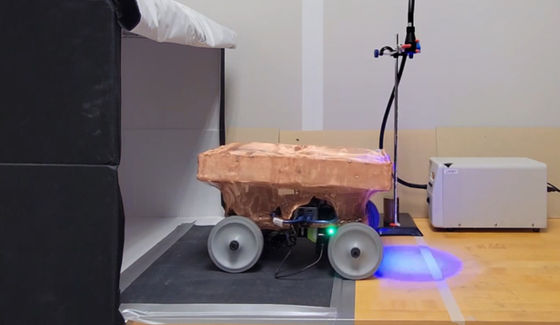A 'bio-hybrid machine' has been developed that incorporates mushroom mycelium into robot electronics

There is growing interest in
Sensorimotor control of robots mediated by electrophysiological measurements of fungal mycelia | Science Robotics
https://www.science.org/doi/10.1126/scirobotics.adk8019
Biohybrid robots controlled by electrical impulses — in mushrooms | Cornell Chronicle
https://news.cornell.edu/stories/2024/08/biohybrid-robots-controlled-electrical-impulses-mushrooms
Engineers Gave a Mushroom a Robot Body And Let It Run Wild : ScienceAlert
https://www.sciencealert.com/engineers-gave-a-mushroom-a-robot-body-and-let-it-run-wild
Many of the biohybrid robots developed to date have used animal cells, which require complicated cultivation procedures and have a short lifespan, posing major challenges in terms of durability.
Focusing on fungi, which form a network of mycelium that transmits electrical signals, are easy to cultivate, and are hardy, a research team from Cornell University and the University of Florence has developed a biohybrid robot that uses mushrooms as sensors and control devices by growing the mycelium of the king oyster mushroom into the robot's electronics.
Speaking about the benefits of using mushrooms, Cornell University's Anand Mishra said: 'Mechanical systems, like passive sensors, can only serve one purpose. But biological systems can respond to touch, light, heat or even unknown signals.'
The system developed by the research team consists of an electrical interface that records and processes the electrophysiological activity of the mycelium in real time, and a control unit inspired by the central pattern generator , a type of neural circuit in the brain.
Using this system, the research team developed two types of robots controlled by mushrooms.
The first is a four-wheeled robot vehicle that moves when exposed to ultraviolet light.

The second is a soft robot with five legs. You can see the robot in action in the video below.
The robot moves slowly, moving its legs at irregular intervals.

The light was shone on the robot.

Then, he moved his feet more quickly than before and moved to the right.

Through three experiments, the research team confirmed that the robot could walk and run using the natural signals of the mycelium; confirmed that it had the ability to respond to its environment by observing how its behavior changed in response to ultraviolet light; and conversely, confirmed that it was possible to completely disable the natural signals of the mycelium.
The team believes that in the future, the biohybrid machine could be used to develop robots that can sense changes in soil chemistry and apply fertilizer at the right time, or automatically respond to rising levels of pollutants.
'By growing mycelium into robotic electronics, we were able to enable the biohybrid machine to sense and respond to its environment,' said Rob Shepherd of Cornell Tech. 'In this case, we used light as an input signal, but in the future we may use chemicals.'
Related Posts:
in Free Member, Video, Science, Creature, Posted by log1l_ks







